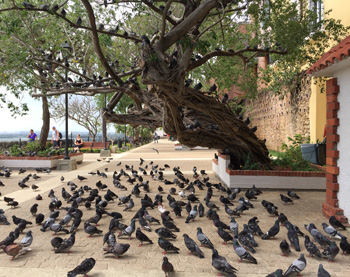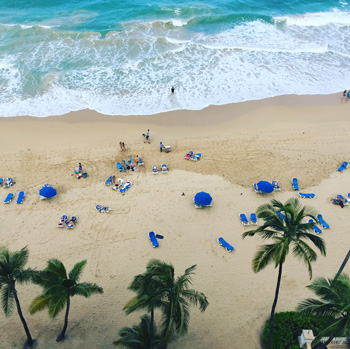As the pink sun is setting over Las Croabas Park, past the breathtaking El Yunque rainforest, and over an hour drive east of San Juan, Puerto Rico’s capital, children are still playing in the ocean watching the waves roll in.
I pay for my savory crescent-shaped cheese empanada in American dollars from a small kiosk nearby before joining a kayaking excursion to Laguna Grande (Big Lagoon). I hear parents calling to their kids in Spanish “Ven aqui” (Come here), holding up enticing bags of churros- traditional Spanish tubular shaped donuts powdered in cinnamon and sugar. Well, I know that I’m in the U.S.A., but it sure doesn’t feel like it.
INTO THE DARKNESS
Soon, I’m paddling like mad against the stubborn current steering my kayak through a canopy of mangroves, already feeling anxious about finding my way back. In darkness, we reach a bioluminescent bay, filled with microorganisms called dinoflagellates. We line up our 12 kayaks side by side, covering ourselves with a tarp. Starlight sparkles start to appear as we sweep our hands through the warm water.
Our Zen moment is interrupted when Manuel, our group leader, shouts out “Follow me back.” On our return trip through a narrow passageway, I can’t see anything in front of me other than the faint blue light dangling from the stern of his kayak. Manuel turns on his jumbo flashlight only for a minute but long enough for me to see hundreds of bats crisscrossing over our heads.
Nancy, my kayak mate, shrieks, “I can’t paddle anymore, I need to close my eyes.” My adrenalin kicks in, I’m now kayaking like a pro but manage to keep calm thinking about a warm shower and malanga croquetas (fritters made from a local root vegetable) I’ll soon be enjoying at the Marriott Hotel where I’m staying, in the trendy Condado neighbourhood.
 SPANISH ROOTS
SPANISH ROOTS
I came to this lush island eager to check out the beautiful beaches, fascinating historic sites and exciting food scene, but what I didn’t expect to find was that Puerto Rico, only 100 miles long, officially known as the Commonwealth of Puerto Rico as well as an unincorporated territory of the United States, has a unique flavor of its own- one that reflects a dynamic blend of both its African and Spanish heritage.
Staring at the Caribbean Sea and creamy sand beach from my balcony, I try to imagine what this island must have looked like to the Spanish explorers. Christopher Columbus (1493) named this archipelago surrounded by the Atlantic Ocean and Caribbean Sea, San Juan Bautista, in honour John the Baptist. It later became known as Puerto Rico (Rich Port) under Juan Ponce de Leon, the first governor of the island. The Spanish ruled for four centuries here until 1898, when, following the American- Spanish war, Puerto Rico became a territory of the U.S.
 CONDADO BEACH FUN
CONDADO BEACH FUN
I’m famished from hours of kayaking, and not shy to eat everything on the tasting menu at La Vista Latin Grill in the San Juan Marriott & Stellaris Casino. Just as I’m finishing my first nibble of chicken alcapurrias (another type of Puerto Rican fritter), Italian born, Chef Cesare Biancalana delivers a delicate shrimp carpaccio in a lemon vinaigrette. The pappardelle pasta is surprisingly light with an osso bucco ragout and I manage to make room for some pan-fried local sea bass served over sautéed garlic spinach and cherry tomatoes cooked in a white wine reduction. Dessert is mind blowing, a crepe filled with mascarpone cheese in a berry sauce.
Although I’m exhausted from my adventurous day, I’m persuaded to hang out at the Coral Lounge in the lobby with friends for some nighttime fun. It’s already midnight and the dance floor is still busy with locals of all ages expertly salsa dancing to the energetic band playing till the early hours.
OLD SAN JUAN
I only have one day to explore colourful Viejo San Juan (Old San Juan), and Spoon Food Tours seems like a perfect fit for me- a deliciously packed morning of eating and sightseeing. Caroline, our dynamic guide, transports us back in time sharing stories of Puerto Rico’s complicated past while walking us through the quiet cobble-stoned streets shaded by giant willowy trees.
Our tour begins at the Plaza del Quinto Centenario, a square erected in celebration of the 500th anniversary of Christopher Columbus’ discovery of the new world. In the centre stands a magnificent 40-foot totem pole made of black granite and pottery. The red clay pottery is said to have been found at a Taino archeological dig; Taino are the indigenous people of Puerto Rico.
First stop is a quick breakfast at Café Don Ruiz, a family-owned roastery that’s been growing its coffee beans since the late 1800’s. This sleek café is located in the Ballaja, a mid 19th century army barracks built for the Spanish troops. I couldn’t resist their beautifully prepared café con leche (coffee with steamed milk) and pan de Mallorca (savoury/ sweet sandwich layered with ham and cheese, cinnamon inside and powdered sugar on top).
En route to our next meal, we pass by Jorge Zeno’s whimsical sculptures of cats and vibrant murals painted by art students on the sides of old buildings. At El Convento, a charming boutique hotel that once served as a 17th Century Carmelite convent, we settle in the courtyard sitting under a century-old Nispero tree bearing beautiful large pink flowering globes of fruit.
I dip my spoon into a glass of bright green gazpacho and taste pureed fresh spinach, sweet avocados, and a hint of tangy green apples. I’m impressed with this inventive version of the traditional Spanish tomato-based cold soup. Bite-sized croquetas follow and I’m loving them- this time they are filled with mashed potatoes, beef and peppers.
Although dessert is offered, I’m more interested in a small plate of fried plantains that comes my way- sweet and decadent just on their own. The tradition of frying plantains comes from the West African slaves who inhabited the island under Spanish rule. Many of the Puerto Rican dishes include plantains as a main ingredient.
LIVING LANDMARKS
Aside from sampling fabulous Puerto Rican food on the itinerary we visit Cathedral de San Juan built in 1521, the second oldest cathedral in the Americas, and dramatic Castillo San Felipe del Morro (aka El Morro), the 400-year-old windswept fort named in honour of Philip ll, King of Spain, overlooking the bay that guarded and defended the port of San Juan.
Our final snack is at the Princesa Gastrobar, in the gardens of the old city jail cells. After sips of Puerto Rican rum we still manage to make our own molletes criollos, an open face sandwich with most of the top piece ripped out. I load it up with pork picadillo (olives, almonds, raisins and capers), place a small slice of brie over the filling, hand torch the cheese on top and devour my bubbling melted masterpiece.
MORE TO EXPLORE
Just as we are about to leave the Princesa, I’m distracted by the lively conversation happening at the table beside us. I catch enough English to understand that they are arguing about where to find the best mofongo on the island. Thankfully, my server Jorge explains that mofongo is a Puerto Rican dish made with green plantains that are mashed in a wooden mortar and pestle and then topped with meat or seafood. The chatter finally subsides after much discussion and they agree that Pinones, an area well known for its many food stands, and only a short cab ride away, is where it’s at. Guess that’s where I’m headed next.
> This article by Rena Godfrey appeared in the Spring/Summer 2016 issue of Dreamscapes – Travel and Lifestyle Magazine.
